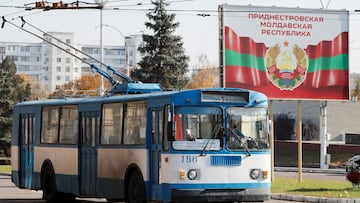Transdniestria, the potential new flashpoint in the Russia-Ukraine war
It’s been two months since Russian President Vladimir Putin’s invasion of the neighbouring country, and now the Moldavan region comes into more focus.

There is no doubt that tensions are rising in the breakaway Moldovan region of Transdniestria, adjacent to Ukraine, where authorities say explosions have hit radio masts and the state security service headquarters in the space of a day. Here’s why the region is emerging as a possible new flashpoint of the war in Ukraine.
What is Transdniestria and why is Russia interested?
The mainly Russian-speaking region broke away from then-Soviet Moldova in 1990. After the breakup of the Soviet Union in 1991, pro-Russian separatists fought a bloody war with the Moldovan government forces. Russia, which already had troops based there, helped mediate an end to the fighting and the region became one of several “frozen conflicts” in the former Soviet region.
Transdniestria is poor and relies heavily on Russian gas. It gets its name from the Dniester river, which divides it from the rest of Moldova. It has its own currency and army, about 7,500 strong. Sheriff FC, from the region’s main city Tiraspol, beat Real Madrid in the group stages of the football Champions League last year.
More on Russia-Ukraine war:
- How will the Russia-Ukraine war impact food exports?
- Trump would have called Putin’s ‘N-word’ bluff
- Putin’s strange gesture during ministerial meeting deciphered
- What has Putin said about the possible incorporation into NATO of Finland and Sweden?
- Zelenskyy announces new Russian assault in the east
No countries recognise the independence of the territory, which lies to Ukraine’s southwest and still uses the Soviet Communist hammer-and-sickle as a state emblem. About 420,000 people live in the region and some people hold more than one passport. Around 220,000 have Moldovan citizenship, 240,000 have Russian citizenship and 130,000 have Ukrainian citizenship.
Why is there so much attention on Transdniestria?
Moscow retains 1,500 peacekeepers on the territory as well as 1,400 soldiers guarding a huge arms depot that has been there since the collapse of the Soviet Union. The presence of Russian troops has raised fears that Moscow could use Transdniestria as a launchpad for some kind of attack on Ukraine’s west, while Kyiv strives to repel Moscow’s new offensive in the east.
On April 23, a senior Russian military official said the second phase of what Moscow calls its “special military operation” included a plan to take full control of southern Ukraine and improve its access to Transdniestria. Russia has already taken control of swathes of Ukraine’s south, but in order to get to Transdniestria it would have to pass through Mykolaiv and Odesa, major cities that remain firmly in Ukrainian hands.
Blasts hit ministry of state security in the capital of Moldova's breakaway region of Transdniestria, TSV television station reports pic.twitter.com/bUIeomTIhd
— TRT World Now (@TRTWorldNow) April 26, 2022
Ukrainian officials have said Moscow could stage “false flag” attacks - designed to look like they were perpetrated by someone other than the person or group responsible for them - in the region that could serve as a pretext for Russian military action. Separatist authorities said this week that several blasts knocked out two radio antennae that broadcast in Russian and hit the ministry of state security. They said there had been another attack on a military unit. The separatists have blamed Ukraine, which deny any connection with the incidents.
The Ukrainian foreign ministry expressed concern on Tuesday about the situation in Transdniestria and condemned what it said were Russian attempts to drag the region into Russia's war against Ukraine.
Related stories
Moldovan authorities are on edge and always sensitive to any sign of worsening security in Transdniestria. On Tuesday, Moldova’s president said the attacks were an attempt by pro-war factions to stoke tensions.
The Kremlin said it was seriously concerned by the news out of Transdniestria, but Russia’s foreign ministry said Moscow wanted to avoid a scenario in which it had to intervene in the region, the RIA news agency reported.

